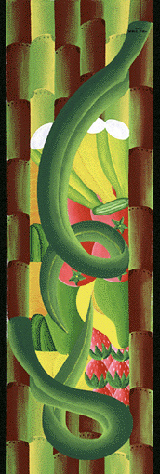Plot Summaries
1934
Jonah's Gourd Vine is Zora Neale Hurston's first novel and the semi-autobiographical account of her parents' lives as they migrated from their birthplace in the Old South of Notasulga, Alabama, to the New South of Eatonville, Florida. The novel provides an inside view of African-American life just after slavery as families try to adjust to freedom. The hero of the story, John Buddy 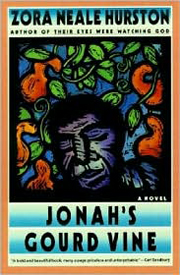 Pearson, is a big, powerful man, "a living exultation," who is born "over de Big Creek," on the wrong side of town. He falls in love with a rich girl, Lucy Potts, who calls him a "big yaller bee-stung" man. She inspires him to go to school, so that he can get to know her better. After a "month of love," they marry much to the disapproval of her parents, who clearly see John's flaws. It takes Lucy longer to realize that her husband is a philanderer who can't control his desires for other women. After he assaults his brother in law, who seeks money from him and accuses him of cheating on his wife, John flees to Florida and later sends for Lucy and their three children. In his new life John discovers his calling--"God done called me tuh preach"-and becomes pastor of Zion Hope Church. Lucy supports his rise and gives him advice; eventually, John is elected mayor of the town. Just as Jonah's Gourd Vine is destined to be cut down, John once again succumbs to the siren call of other women. He is starting to lose his reputation in the community when Lucy dies. After her death, no one is left who can prop him up and, thus, he continues his downward slide. John marries the woman with whom he had committed adultery but she turns against him by practicing conjure. John loses his position in the church and divorces his second wife. At the end of the story, John has married again, for the third time, but can't resist a young woman who seeks him out. After their assignation, while driving home, he is hit by a train and dies.
Pearson, is a big, powerful man, "a living exultation," who is born "over de Big Creek," on the wrong side of town. He falls in love with a rich girl, Lucy Potts, who calls him a "big yaller bee-stung" man. She inspires him to go to school, so that he can get to know her better. After a "month of love," they marry much to the disapproval of her parents, who clearly see John's flaws. It takes Lucy longer to realize that her husband is a philanderer who can't control his desires for other women. After he assaults his brother in law, who seeks money from him and accuses him of cheating on his wife, John flees to Florida and later sends for Lucy and their three children. In his new life John discovers his calling--"God done called me tuh preach"-and becomes pastor of Zion Hope Church. Lucy supports his rise and gives him advice; eventually, John is elected mayor of the town. Just as Jonah's Gourd Vine is destined to be cut down, John once again succumbs to the siren call of other women. He is starting to lose his reputation in the community when Lucy dies. After her death, no one is left who can prop him up and, thus, he continues his downward slide. John marries the woman with whom he had committed adultery but she turns against him by practicing conjure. John loses his position in the church and divorces his second wife. At the end of the story, John has married again, for the third time, but can't resist a young woman who seeks him out. After their assignation, while driving home, he is hit by a train and dies.
1935
Mules and Men is Hurston's first published book of folklore. In a letter to her mentor, the Father of Anthropology, Franz Boas, Hurston worries that the book is too "unscientific," because she wishes to attract the "average reader." In his Introduction, Franz Boas reassures her by pointing out her unique contribution: "It is the great merit of Miss Hurston's work that she entered into  the homely life of the southern Negro as one of them and was fully accepted as such by the companions of her childhood." He goes on to say that the narrator of the book possesses the "charm of a loveable personality and of a revealing style." Using the "spy-glass of Anthropology," which Boas had taught her, Hurston dons an objective and non-judgmental persona as a guide to the folklore. Mules and Men is divided into two parts: the first section deals with Florida and the second, with New Orleans. Part One starts off in Eatonville as the narrator goes home to gather "all them old-time tales about Brer Rabbit and Brer Bear," in order to "set them down before it's too late." She's looking for "them big old lies we tell when we're jus' sittin' around here on the porch doin' nothing"-which she knows have value in the world outside as cultural artifacts. In her role as scientist, she journeys beyond her own village, to Polk County, "Where they really lies up a mess and . . . . where dey makes up all de songs." She presents 70 tales by the time the first section of the book ends. The next half of Mules and Men concerns her visit to New Orleans to collect information about hoodoo. She meets Luke Turner who tells her about his famous aunt, Marie Leveau, a hoodoo priestess born in 1837. Turner assists Hurston in her own inititation ritual, in which she lay face down on a snake skin for 69 hours: "I had five psychic experiences and awoke at last with no feeling of hunger, only one of exaltation." Other rituals are also listed, such as how to get a man, a routine to keep a husband true, and how to make a death. At the end is an appendix with the following topics: "Negro Songs with Music," "Formulae of Hoodoo Doctors," "Paraphernalia of Conjure," "Prescriptions of Root Doctors."
the homely life of the southern Negro as one of them and was fully accepted as such by the companions of her childhood." He goes on to say that the narrator of the book possesses the "charm of a loveable personality and of a revealing style." Using the "spy-glass of Anthropology," which Boas had taught her, Hurston dons an objective and non-judgmental persona as a guide to the folklore. Mules and Men is divided into two parts: the first section deals with Florida and the second, with New Orleans. Part One starts off in Eatonville as the narrator goes home to gather "all them old-time tales about Brer Rabbit and Brer Bear," in order to "set them down before it's too late." She's looking for "them big old lies we tell when we're jus' sittin' around here on the porch doin' nothing"-which she knows have value in the world outside as cultural artifacts. In her role as scientist, she journeys beyond her own village, to Polk County, "Where they really lies up a mess and . . . . where dey makes up all de songs." She presents 70 tales by the time the first section of the book ends. The next half of Mules and Men concerns her visit to New Orleans to collect information about hoodoo. She meets Luke Turner who tells her about his famous aunt, Marie Leveau, a hoodoo priestess born in 1837. Turner assists Hurston in her own inititation ritual, in which she lay face down on a snake skin for 69 hours: "I had five psychic experiences and awoke at last with no feeling of hunger, only one of exaltation." Other rituals are also listed, such as how to get a man, a routine to keep a husband true, and how to make a death. At the end is an appendix with the following topics: "Negro Songs with Music," "Formulae of Hoodoo Doctors," "Paraphernalia of Conjure," "Prescriptions of Root Doctors."
1937
Their Eyes Were Watching God is the story of the founding of the all-black community of Eatonville, Florida, around the turn of the 20th century and presents one of the first depictions of a strong African-American heroine in American literature. The novel relates the founding of the town, with characters speaking in dialect. The story is related using a frame technique. Janie Crawford 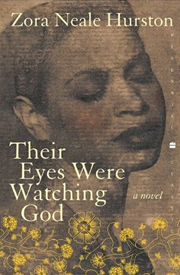 has just returned to town after many adventures, which she recounts to her best friend. Janie goes back in time, beginning with her childhood when she is being raised by her grandmother, Nanny. When Janie enters puberty, Nanny becomes alarmed at Janie's sexual precociousness and quickly marries her off to Logan Killocks, a small landholder. Logan forces Janie to work in the fields, which makes her feel "a mule of the world." When Janie meets a passing handsome man, Jody Starks, she is attracted by his bravado at creating a town and the chance to escape her field-cropper existence. Starks promises her that she will sit on the porch of her own home and live a prosperous life. Janie leaves Killocks and joins Starks in his new enterprise in Eatonville. She enjoys her new life for 20 years, until Starks becomes threatened by her beauty and popularity in the town. She finally fights back and insults him about his manhood. It's uncertain whether the insult is the direct cause of Starks's wasting away from kidney disease and dying. Janie, as the mayor's widow, lives apart from the community until she meets Tea Cake, a wandering field worker. She falls in love with him and follows him to the Muck, the area around the Everglades, where she joyfully works in the fields alongside him and learns how to tell her own tales. Their happy life ends when a hurricane uproots their existence. As they escape the flooding Lake Okeechobee, Tea Cake is bitten by a rabid dog and becomes ill with rabies. In a mad rage, he attacks Janie who shoots him dead in self defense. The story ends when she returns to Eatonville and resumes her life in the community, presumably as a teller of tales.
has just returned to town after many adventures, which she recounts to her best friend. Janie goes back in time, beginning with her childhood when she is being raised by her grandmother, Nanny. When Janie enters puberty, Nanny becomes alarmed at Janie's sexual precociousness and quickly marries her off to Logan Killocks, a small landholder. Logan forces Janie to work in the fields, which makes her feel "a mule of the world." When Janie meets a passing handsome man, Jody Starks, she is attracted by his bravado at creating a town and the chance to escape her field-cropper existence. Starks promises her that she will sit on the porch of her own home and live a prosperous life. Janie leaves Killocks and joins Starks in his new enterprise in Eatonville. She enjoys her new life for 20 years, until Starks becomes threatened by her beauty and popularity in the town. She finally fights back and insults him about his manhood. It's uncertain whether the insult is the direct cause of Starks's wasting away from kidney disease and dying. Janie, as the mayor's widow, lives apart from the community until she meets Tea Cake, a wandering field worker. She falls in love with him and follows him to the Muck, the area around the Everglades, where she joyfully works in the fields alongside him and learns how to tell her own tales. Their happy life ends when a hurricane uproots their existence. As they escape the flooding Lake Okeechobee, Tea Cake is bitten by a rabid dog and becomes ill with rabies. In a mad rage, he attacks Janie who shoots him dead in self defense. The story ends when she returns to Eatonville and resumes her life in the community, presumably as a teller of tales.
1938
Tell My Horse is Zora Neale Hurston's account of her anthropological fieldwork in Jamaica and Haiti in 1936-37. The book is divided into the following three parts: the first section presents material on Jamaica; the second concerns "The Politics and Personalities of Haiti"; and the third, describes voodoo practices in Haiti. The book, on the whole, is unscientific and  disorganized. In his review of Tell My Horse, Alain Locke dismisses it as "anthropological gossip." The problem is that the first two sections deal with the politics and history of the islands, rather than their folklore and literature, which would better engage Hurston's strengths as a writer. The voodoo material, on the other hand, gives the reader insight into a mysterious realm. Hurston powerfully describes voodoo's seductive power: "It is the old, old, mysticism of the world in African terms. Voodoo is a religion of creation and life. It is the worship of the sun, the water and other natural forces, but the symbolism is no better understood than that of other religions." The most interesting section concerns Hurston's studies of zombies and her belief in their existence: "I know that here are zombies in Haiti." She provides photographs of a zombie and concludes: "What is the whole truth and nothing else but the truth about zombies? I do not know, but I know that I saw the broken remnant, relic, refuse of Felicia Felix-Mentor in a hospital yard." Ishmael Reed praises the book, with its mix of genres, as a postmodernist text and claims that its greatest accomplishment is "in revealing the profound beauty and appeal of a faith older than Christianity, Buddhism, and Islam, a faith that has survived in spite of its horrendously bad reputation and the persecution of its followers."
disorganized. In his review of Tell My Horse, Alain Locke dismisses it as "anthropological gossip." The problem is that the first two sections deal with the politics and history of the islands, rather than their folklore and literature, which would better engage Hurston's strengths as a writer. The voodoo material, on the other hand, gives the reader insight into a mysterious realm. Hurston powerfully describes voodoo's seductive power: "It is the old, old, mysticism of the world in African terms. Voodoo is a religion of creation and life. It is the worship of the sun, the water and other natural forces, but the symbolism is no better understood than that of other religions." The most interesting section concerns Hurston's studies of zombies and her belief in their existence: "I know that here are zombies in Haiti." She provides photographs of a zombie and concludes: "What is the whole truth and nothing else but the truth about zombies? I do not know, but I know that I saw the broken remnant, relic, refuse of Felicia Felix-Mentor in a hospital yard." Ishmael Reed praises the book, with its mix of genres, as a postmodernist text and claims that its greatest accomplishment is "in revealing the profound beauty and appeal of a faith older than Christianity, Buddhism, and Islam, a faith that has survived in spite of its horrendously bad reputation and the persecution of its followers."
1939
Moses, Man of the Mountain is Zora Neale Hurston's attempt at re-writing (or re-righting) the Bible from an Afro-American perspective. She retells the story of the Exodus, which is the triumphant tale of Moses and the Israelites's escape from Egyptian slavery. This story has resonated in the African-American community for centuries, according to Albert Raboteau, who writes 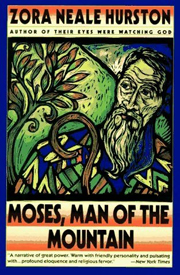 in Slave Religion that "the symbols, myths and values of Judeo-Christian tradition helped form the slave community's image of itself."
Hurston's image of Moses is that he is African and his people are African-Americans. (Freud, for one, advanced the theory that Moses was Egyptian in articles that he wrote for the journal, Imago, in 1937). She then tells Moses's story, beginning with his escape in the basket of bulrushes and culminating in his role as the great conjurer, the "power doctor" of humankind. In between she adds her own and/or embellishes sketchy legends about Moses, i.e. that Moses grows up in the palace of his grandfather, the pharaoh; is appointed commander of the Egyptian armies; and begs the Egyptian priests to teach him their magic. At the height of his power and heroism, she dramatizes his growing awareness of the lives of the Hebrew slaves and his encounter with the burning bush in the wilderness. In Hurston's view, Moses is a down-to-earth man; yet, he is also a hoodoo master: "He knows the ways and meaning of Light and he heard the voice of Darkness and knew its thoughts." She shows how he is transformed once he takes up the cause of the oppressed.
in Slave Religion that "the symbols, myths and values of Judeo-Christian tradition helped form the slave community's image of itself."
Hurston's image of Moses is that he is African and his people are African-Americans. (Freud, for one, advanced the theory that Moses was Egyptian in articles that he wrote for the journal, Imago, in 1937). She then tells Moses's story, beginning with his escape in the basket of bulrushes and culminating in his role as the great conjurer, the "power doctor" of humankind. In between she adds her own and/or embellishes sketchy legends about Moses, i.e. that Moses grows up in the palace of his grandfather, the pharaoh; is appointed commander of the Egyptian armies; and begs the Egyptian priests to teach him their magic. At the height of his power and heroism, she dramatizes his growing awareness of the lives of the Hebrew slaves and his encounter with the burning bush in the wilderness. In Hurston's view, Moses is a down-to-earth man; yet, he is also a hoodoo master: "He knows the ways and meaning of Light and he heard the voice of Darkness and knew its thoughts." She shows how he is transformed once he takes up the cause of the oppressed.
1942
Dust Tracks on a Road is Zora Neale Hurston's memoir of her life from childhood to her fifties. She sums up her experiences: "I have been in Sorrow's kitchen and licked out all the pots. Then I have stood on the peaky mountain wrapped in rainbows, with a harp and a sword in my hands." She writes movingly of her early childhood in Eatonville, of a home that is "the  center of the world," and of a loving mother who urges her to "jump at de sun." Yet, she expresses her longings to explore the outside world and feels that she "ought to walk out to the horizon and see what the end of the world was like." Her extraordinary journey to the outside world begins when her mother dies in 1904 and Hurston is forced out of the family home to live with her siblings in Jacksonville. She describes her struggle to obtain an education at Howard University and Barnard College and establish a career as a self-supporting writer. Along the way, she discusses her views about love, religion, race, and politics. Yet, her biographer Robert Hemenway claims that Hurston only gives the illusion of revealing herself; finally, at the end, she remains an enigma. According to Hemenway, Dust Tracks on a Road "fails as autobiography because it is a text deliberately less than its author's talents." It "presents an image of its author that fails to conform with either her public career or her private experience." In fact, Hurston begins the autobiography with a lie, claiming that she was born in the all-black town of Eatonville, rather than in the Deep South of Alabama. Hemenway feels that this and other "lies" in the memoir only deepen "the mystery" surrounding Hurston; she never answers the question: "who is Zora Neale Hurston?"
center of the world," and of a loving mother who urges her to "jump at de sun." Yet, she expresses her longings to explore the outside world and feels that she "ought to walk out to the horizon and see what the end of the world was like." Her extraordinary journey to the outside world begins when her mother dies in 1904 and Hurston is forced out of the family home to live with her siblings in Jacksonville. She describes her struggle to obtain an education at Howard University and Barnard College and establish a career as a self-supporting writer. Along the way, she discusses her views about love, religion, race, and politics. Yet, her biographer Robert Hemenway claims that Hurston only gives the illusion of revealing herself; finally, at the end, she remains an enigma. According to Hemenway, Dust Tracks on a Road "fails as autobiography because it is a text deliberately less than its author's talents." It "presents an image of its author that fails to conform with either her public career or her private experience." In fact, Hurston begins the autobiography with a lie, claiming that she was born in the all-black town of Eatonville, rather than in the Deep South of Alabama. Hemenway feels that this and other "lies" in the memoir only deepen "the mystery" surrounding Hurston; she never answers the question: "who is Zora Neale Hurston?"
1948
In Seraph on the Suwanee, Zora Neale Hurston portrays white Florida crackers, which is a departure from her usual cast of African-American characters. Her original publisher had rejected two manuscripts that featured black characters; thus, Hurston turned to white characters. In this novel, she attempts to create "a true picture of the South," by showing the similarities between 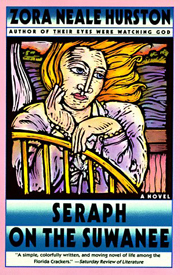 black and white cultures. On the one hand, an area that Hurston claims is similar is dialect. She denies that black linguistic structures are unique or different from white cracker speech: "I think that it should be pointed out that what is known as Negro dialect in the South is no such thing." On the other hand, an area that is not at all similar concerns the nature of her heroines. The heroine in Seraph on the Suwanee, Arvay Henson, is not at all similar to the intrepid African-American heroine, Janie Crawford, in Their Eyes Were Watching God. Arvay has no self esteem, courage, or independent spirit. As the story opens in 1905, Arvay has been having "hysterical seizures," whenever "some extra brash young gallant had forced himself upon her to the extent of seeing her home" after church. However, she can't resist Jim Meserve, a newcomer to town, who is not discouraged by her shyness. She never thinks she is worthy of this self-confident, good-looking man. He, on the other hand, adores her but reinforces her sense of inferiority by claiming that: "women folks don't have no mind to make up nohow. They wasn't made for that." He proposes to her and, before they have a chance to have the wedding about which she dreams, he rapes her under a mulberry tree. Immediately, he takes her to a justice of the peace and marries her. They prosper in their married life, mainly because Jim works hard, is ambitious, and successful in his jobs. Their tragedy is that their firstborn son, Earl, is born retarded and disabled. When Earl is a teenager, he sexually assaults a neighbor girl and runs into the swamp behind his home. Jim chases after him, only to have Earl attempt to kill him. Earl is shot dead, instead, which breaks Arvay's heart. She withdraws from Jim in her grief. In a poignant scene, later in the novel, Arvay still in a withdrawn state can't act to save Jim when he is threatened by an eight-foot rattlesnake. Jim is able to save himself but is repulsed by Arvay's inability to connect with him. He complains: "I don't want that stand-still, hap-hazard kind of love. I'm just as hungry as a dog for a knowing and a doing kind of love. You love like a coward." They never resolve their differences, but reach a level of peace at the end of the novel. Arvay's other children are grown up, so she transfers her mothering impulses to Jim, who is now a shrimp boat captain.
black and white cultures. On the one hand, an area that Hurston claims is similar is dialect. She denies that black linguistic structures are unique or different from white cracker speech: "I think that it should be pointed out that what is known as Negro dialect in the South is no such thing." On the other hand, an area that is not at all similar concerns the nature of her heroines. The heroine in Seraph on the Suwanee, Arvay Henson, is not at all similar to the intrepid African-American heroine, Janie Crawford, in Their Eyes Were Watching God. Arvay has no self esteem, courage, or independent spirit. As the story opens in 1905, Arvay has been having "hysterical seizures," whenever "some extra brash young gallant had forced himself upon her to the extent of seeing her home" after church. However, she can't resist Jim Meserve, a newcomer to town, who is not discouraged by her shyness. She never thinks she is worthy of this self-confident, good-looking man. He, on the other hand, adores her but reinforces her sense of inferiority by claiming that: "women folks don't have no mind to make up nohow. They wasn't made for that." He proposes to her and, before they have a chance to have the wedding about which she dreams, he rapes her under a mulberry tree. Immediately, he takes her to a justice of the peace and marries her. They prosper in their married life, mainly because Jim works hard, is ambitious, and successful in his jobs. Their tragedy is that their firstborn son, Earl, is born retarded and disabled. When Earl is a teenager, he sexually assaults a neighbor girl and runs into the swamp behind his home. Jim chases after him, only to have Earl attempt to kill him. Earl is shot dead, instead, which breaks Arvay's heart. She withdraws from Jim in her grief. In a poignant scene, later in the novel, Arvay still in a withdrawn state can't act to save Jim when he is threatened by an eight-foot rattlesnake. Jim is able to save himself but is repulsed by Arvay's inability to connect with him. He complains: "I don't want that stand-still, hap-hazard kind of love. I'm just as hungry as a dog for a knowing and a doing kind of love. You love like a coward." They never resolve their differences, but reach a level of peace at the end of the novel. Arvay's other children are grown up, so she transfers her mothering impulses to Jim, who is now a shrimp boat captain.


